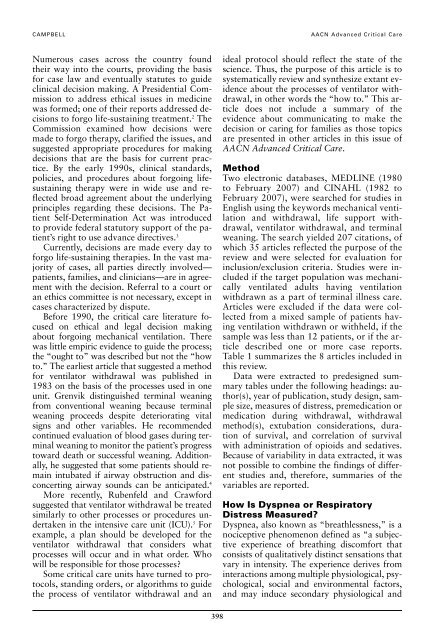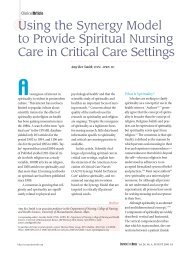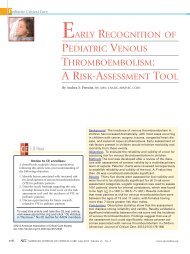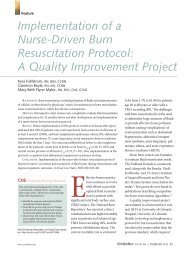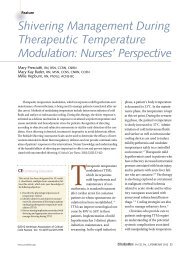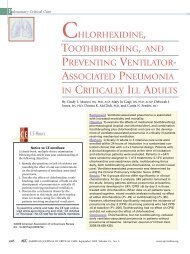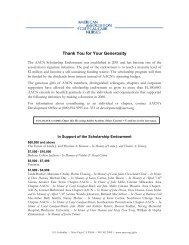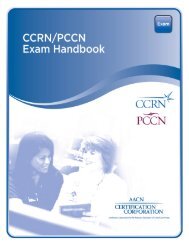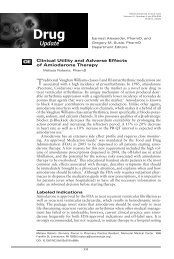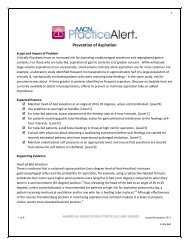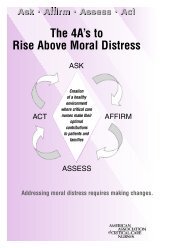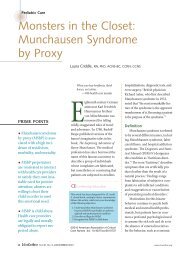How to Withdraw Mechanical Ventilation - American Association of ...
How to Withdraw Mechanical Ventilation - American Association of ...
How to Withdraw Mechanical Ventilation - American Association of ...
Create successful ePaper yourself
Turn your PDF publications into a flip-book with our unique Google optimized e-Paper software.
AACN18_4_397-403 10/20/07 14:23 Page 398<br />
CAMPBELL AACN Advanced Critical Care<br />
Numerous cases across the country found<br />
their way in<strong>to</strong> the courts, providing the basis<br />
for case law and eventually statutes <strong>to</strong> guide<br />
clinical decision making. A Presidential Commission<br />
<strong>to</strong> address ethical issues in medicine<br />
was formed; one <strong>of</strong> their reports addressed decisions<br />
<strong>to</strong> forgo life-sustaining treatment. 2 The<br />
Commission examined how decisions were<br />
made <strong>to</strong> forgo therapy, clarified the issues, and<br />
suggested appropriate procedures for making<br />
decisions that are the basis for current practice.<br />
By the early 1990s, clinical standards,<br />
policies, and procedures about forgoing lifesustaining<br />
therapy were in wide use and reflected<br />
broad agreement about the underlying<br />
principles regarding these decisions. The Patient<br />
Self-Determination Act was introduced<br />
<strong>to</strong> provide federal statu<strong>to</strong>ry support <strong>of</strong> the patient’s<br />
right <strong>to</strong> use advance directives. 3<br />
Currently, decisions are made every day <strong>to</strong><br />
forgo life-sustaining therapies. In the vast majority<br />
<strong>of</strong> cases, all parties directly involved—<br />
patients, families, and clinicians—are in agreement<br />
with the decision. Referral <strong>to</strong> a court or<br />
an ethics committee is not necessary, except in<br />
cases characterized by dispute.<br />
Before 1990, the critical care literature focused<br />
on ethical and legal decision making<br />
about forgoing mechanical ventilation. There<br />
was little empiric evidence <strong>to</strong> guide the process;<br />
the “ought <strong>to</strong>” was described but not the “how<br />
<strong>to</strong>.” The earliest article that suggested a method<br />
for ventila<strong>to</strong>r withdrawal was published in<br />
1983 on the basis <strong>of</strong> the processes used in one<br />
unit. Grenvik distinguished terminal weaning<br />
from conventional weaning because terminal<br />
weaning proceeds despite deteriorating vital<br />
signs and other variables. He recommended<br />
continued evaluation <strong>of</strong> blood gases during terminal<br />
weaning <strong>to</strong> moni<strong>to</strong>r the patient’s progress<br />
<strong>to</strong>ward death or successful weaning. Additionally,<br />
he suggested that some patients should remain<br />
intubated if airway obstruction and disconcerting<br />
airway sounds can be anticipated. 4<br />
More recently, Rubenfeld and Crawford<br />
suggested that ventila<strong>to</strong>r withdrawal be treated<br />
similarly <strong>to</strong> other processes or procedures undertaken<br />
in the intensive care unit (ICU). 5 For<br />
example, a plan should be developed for the<br />
ventila<strong>to</strong>r withdrawal that considers what<br />
processes will occur and in what order. Who<br />
will be responsible for those processes?<br />
Some critical care units have turned <strong>to</strong> pro<strong>to</strong>cols,<br />
standing orders, or algorithms <strong>to</strong> guide<br />
the process <strong>of</strong> ventila<strong>to</strong>r withdrawal and an<br />
398<br />
ideal pro<strong>to</strong>col should reflect the state <strong>of</strong> the<br />
science. Thus, the purpose <strong>of</strong> this article is <strong>to</strong><br />
systematically review and synthesize extant evidence<br />
about the processes <strong>of</strong> ventila<strong>to</strong>r withdrawal,<br />
in other words the “how <strong>to</strong>.” This article<br />
does not include a summary <strong>of</strong> the<br />
evidence about communicating <strong>to</strong> make the<br />
decision or caring for families as those <strong>to</strong>pics<br />
are presented in other articles in this issue <strong>of</strong><br />
AACN Advanced Critical Care.<br />
Method<br />
Two electronic databases, MEDLINE (1980<br />
<strong>to</strong> February 2007) and CINAHL (1982 <strong>to</strong><br />
February 2007), were searched for studies in<br />
English using the keywords mechanical ventilation<br />
and withdrawal, life support withdrawal,<br />
ventila<strong>to</strong>r withdrawal, and terminal<br />
weaning. The search yielded 207 citations, <strong>of</strong><br />
which 35 articles reflected the purpose <strong>of</strong> the<br />
review and were selected for evaluation for<br />
inclusion/exclusion criteria. Studies were included<br />
if the target population was mechanically<br />
ventilated adults having ventilation<br />
withdrawn as a part <strong>of</strong> terminal illness care.<br />
Articles were excluded if the data were collected<br />
from a mixed sample <strong>of</strong> patients having<br />
ventilation withdrawn or withheld, if the<br />
sample was less than 12 patients, or if the article<br />
described one or more case reports.<br />
Table 1 summarizes the 8 articles included in<br />
this review.<br />
Data were extracted <strong>to</strong> predesigned summary<br />
tables under the following headings: author(s),<br />
year <strong>of</strong> publication, study design, sample<br />
size, measures <strong>of</strong> distress, premedication or<br />
medication during withdrawal, withdrawal<br />
method(s), extubation considerations, duration<br />
<strong>of</strong> survival, and correlation <strong>of</strong> survival<br />
with administration <strong>of</strong> opioids and sedatives.<br />
Because <strong>of</strong> variability in data extracted, it was<br />
not possible <strong>to</strong> combine the findings <strong>of</strong> different<br />
studies and, therefore, summaries <strong>of</strong> the<br />
variables are reported.<br />
<strong>How</strong> Is Dyspnea or Respira<strong>to</strong>ry<br />
Distress Measured?<br />
Dyspnea, also known as “breathlessness,” is a<br />
nociceptive phenomenon defined as “a subjective<br />
experience <strong>of</strong> breathing discomfort that<br />
consists <strong>of</strong> qualitatively distinct sensations that<br />
vary in intensity. The experience derives from<br />
interactions among multiple physiological, psychological,<br />
social and environmental fac<strong>to</strong>rs,<br />
and may induce secondary physiological and


